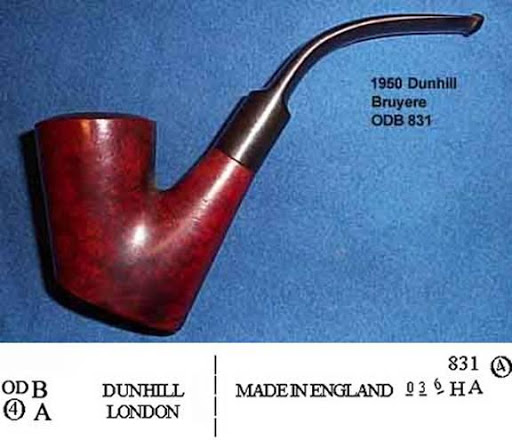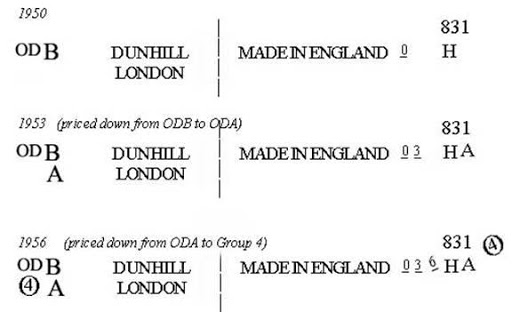Deciphering an ODB 831
Written by John C. Loring
Contributed by Jean-Christophe Bienfait
The Dunhill 831 is one of those seldom seen ‘ODA’ shapes difficult to find if you look for it, but given its small size and awkward shape easy to pass on if you happen upon it. One though is an ongoing mystery for me and so remains on my rack.
When the pipe was first brought to my attention its nomenclature as described to me made no sense at all:
The 800 shape series was not introduced until 1950 so the apparent initial “3” datecode seemed to date it to 1953, but in several respects the remaining elements of the nomenclature were inconsistent with that dating, to wit: (a) Dunhill pipes were stamped with a patent number until 1955 this one was not, (b) Dunhill stopped using “LONDON” under “DUNHILL” in 1951, but this pipe was so stamped, (c) in 1953 an OD stamp would have the shape number stamped immediately below, i.e. ODB / 831, but not on this pipe; and (d) what were the Group 4 stamps, two no less, and two “A”s and an “H” doing there. Nothing made sense, not even a ‘fake’ for why would any one sophisticated enough to forge a Dunhill ruin everything with such cockamamie nomenclature. In short, a pipe that seeming could not exist in a rational universe.
Giving the matter some thought, I suggested to the then owner that he might have missed a “0”, a 1950 date code, in his nomenclature description to me, for with a 1950 datecode the pipe might begin to make sense, at least (i) the “LONDON” part which would be seen on a 1950 or 1951 ‘ODA’, and (ii) the ‘831’ shape number stamp on the non-brand side of the shank, which would be seen on a 1950 pipe. Sure enough a second look by the owner brought back a positive response. Of course that hardly resolved all the questions. But I was hooked, for real or not it was at the least an interesting pipe worthy of thought if not smoke - a trade was arranged and the pipe arrived:
Pipe in hand, I was able to discount ‘fake’, for (i) ignoring the nomenclature, the pipe (including the bit) is clearly a Dunhill; (ii) the nomenclature while collectively seemingly absurd, taken in its individual parts are correct Dunhill stamps; and (iii) the nomenclature is well worn (fakes tend to have crisp nomenclature). All of this ruled out, at least to my mind, forgery. On the other hand my experience has taught me to equally discount ‘factory error’ when it comes to Dunhill stampings. As with Job, if you don’t understand them, you can generally trust that the emphasis should be on the “you”.
Trying to decipher the nomenclature with the pipe in hand, my first thought was that the “(4) A” stamp on the brand side had to be read as ‘group 4 Bruyere’ since that in fact appeared to be the true size and finish. But then that was not how the reverse side was stamped and, the “A” on both sides was the wrong as it was too large in comparison to the “(4)”. This led me to two further thoughts:
First, a recently discovered short but very important December 1952 Dunhill factory memo had just come to my attention. In the post war 1940’s Dunhill found it extremely difficult to source the Italian briar necessary for its smooth finished pipes. However, a notation on the memo just in hand recounted that some such briar had in fact been obtained in 1948 and was used for carving shapes 806 – 832 which were price stamped ODB. The memo was further to the effect that “in future”, i.e. beginning in 1953, those shapes would be priced as ODAs rather then ODBs (I assume because Calabrian briar was by then more available).
Secondly, I realized that I had seen some late 1940s/early 1950s DRs with one letter grade stamped below another. Previously I had been unsure of the meaning of that double DR grade stamping but the oversized “A”s on my pipe while too large for the Bruyere “A” finish stamp were in fact just right for the OD “A” grade stamp. So putting everything together, the natural conclusion for the pipe at hand seemed to be that the “(4) A” on the brand side had to read not as one grade/finish stamp but as two grade stamps: the “A” being stamped, per the second datecode, in 1953 to signify that the pipe was being priced down from an ODB to an ODA. and the “(4)” being stamped in 1956, the third datecode, to indicate that the still unsold pipe was then further reduced in price from an ODA to a Group 4. This interpretation would seem consistent with the reverse side shank stampings for not only is it apparent on that side that the “A” and “(4)” were separately stamped but further the ‘squeezed-in’ nature of both the datecode “6” and the group size “(4)” stamps on that side suggests that those two stamps were both stamped at the same time. Lastly, it is also consistent with later dated 831s I have seen which were price stamped at inception as Group 4s.
This then suggests that the history of the stampings on the pipe at hand was as follows:
And with some confidence this is where I am today.
Still the pipe remains a mystery. First, where is the patent number stamp? In the 1910s and into the 1920s’ when a pipe was not fitted with an inner tube it was Dunhill’s practice to not stamp such a pipe with a patent (or ‘inner tube’). And from all appearances the pipe at hand was not fitted with an inner tube. However, heretofore it has been my understanding that beginning in the late 1920’s a patent number was stamped regardless of whether an inner tube was fitted. Second, I still have absolutely no idea what an “H” stamp stands for.
Perhaps though this is as it should be. This is a pipe of great character, she is a first year OD 800 series, few of which are known, and her shank bears witness to much history. Still, she’s hardly a thing of beauty, all those years unsold testify she never was - rarely has she warmed to the lips. Yet unlike so many fairer, wrapped in mystery she remains on my rack – an interesting pipe.
Postscript: Sometime after writing the above I happened to note that a 1949 LC of mine also lacks a patent number stamp. From what I can determine LCs were not fitted with inner tubes.
Back to Loring's articles here


